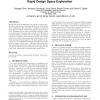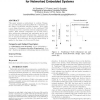CODES
2006
IEEE
14 years 5 months ago
2006
IEEE
Process variability has a detrimental impact on the performance of memories and other system components, which can lead to parametric yield loss at the system level due to timing ...
CODES
2006
IEEE
14 years 5 months ago
2006
IEEE
Transaction-level modeling has been touted to improve simulation performance and modeling efficiency for early design space exploration. But no tools are available to generate suc...
CODES
2006
IEEE
14 years 5 months ago
2006
IEEE
Embedded system optimization typically considers objectives such as cost, timing, buffer sizes and power consumption. Robustness criteria, i.e. sensitivity of the system to variat...
CODES
2006
IEEE
14 years 5 months ago
2006
IEEE
For modern embedded systems, the complexity of embedded applications has reached a point where the performance requirements of these applications can no longer be supported by emb...
CODES
2006
IEEE
14 years 5 months ago
2006
IEEE
Virtual platform (ViP), or ESL (Electronic System Level) simulation model, is one of the most widely renowned system level design techniques. In this paper, we present a case stud...
CODES
2006
IEEE
14 years 5 months ago
2006
IEEE
Time-critical multi-processor systems require guaranteed services in terms of throughput, bandwidth etc. in order to comply to hard real-time constraints. However, guaranteedservi...
CODES
2006
IEEE
14 years 5 months ago
2006
IEEE
In deep sub-micron technology, the crosstalk effect between adjacent wires has become an important issue, especially between long on-chip buses. This effect leads to the increas...
CODES
2006
IEEE
14 years 5 months ago
2006
IEEE
Reliability in embedded processors can be improved by control flow checking and such checking can be conducted using software or hardware. Proposed software-only approaches suffe...
CODES
2006
IEEE
14 years 5 months ago
2006
IEEE
This paper presents a methodology to combine Transaction Level Modeling and System/Network co-simulation for the design of networked embedded systems. As a result, a new design di...
CODES
2006
IEEE
14 years 5 months ago
2006
IEEE
Multi-million gate System-on-Chip (SoC) designs increasingly rely on Intellectual Property (IP) blocks. However, due to technology scaling the leakage power consumption of the IP ...



